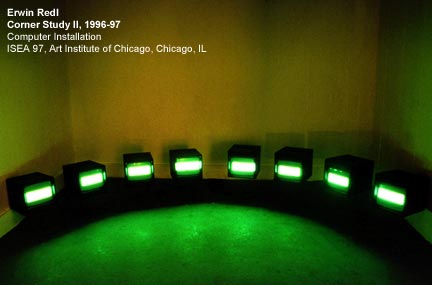
Signal to Noise
A group exhibition of works in light and sound featuring work by Atsushi Nishijima, Erwin Redl, Laurie Spiegel and Heather Wagner
Curated by Heather Wagner
September 10 – October 19, 2002
Opening Reception: Tuesday, September 10th, 6-8pm

Location One is happy to present “Signal to Noise“, a group exhibition featuring works that explore the relationship of sound and light waves. Not merely illustrations of audio-visual synaesthesia, several of the pieces act literally as transducers, that is, devices that convert input energy of one form into output energy of another.The range of frequencies detectable by the human ear is about 20 Hz to 20,000 Hz, and the visible light spectrum is 400 terahertz (red light) to 740 terahertz (violet light). But there are also frequencies like radio waves, microwaves, infrared and ultraviolet light that, unless converted to a human-readable format, course through our environments invisibly and silently.
The notion of seeing the Invisible is both seductive and ordinary. From night vision goggles and microscopes to consumer software like iTunes that invites you to “visualize your music”; digital audio tools that render music as waveforms on a monitor, allowing an audio engineer to edit both visually and aurally, we are accustomed to a kind of mediated synaesthesia.
But in a sense, bringing to light the Invisible can be thought of as a metaphor for what all art (not to mention religion and philosophy) attempts to do. In “Signal to Noise” the artworks act as translators of sound waves to light waves (or vice versa) in elegant, sometimes quite low-tech and simple examples of this phenomenon.
Atsushi Nishijima, trained in experimental and contemporary music, creates sculptures and installations, which emphasize the idea that sound, and thereby music, is inherent in all objects and environments. He was artist-in-residence from Japan at Location One in 2001.
Erwin Redl uses sound and light to create both stunning large-scale installations and smaller meditative pieces. Most recently, his LED grid piece “Matrix VI” adorned the façade of the Whitney Museum for the 2002 Biennial.
Laurie Spiegel is a pioneer in computer music and one of the first composers to experiment with concepts of visual music. Though she navigates the upper echelons of high technology she “sees the computer as a new kind of folk instrument”. As she says, “music is a way to deal with the extreme intensity of moment to moment conscious existence.”
Heather Wagner has created sound installations and internet performances that explore ethernity, the imaginary connection between cyberspace and dreams. She also plays drums and is grateful to the curator for thinking of her.